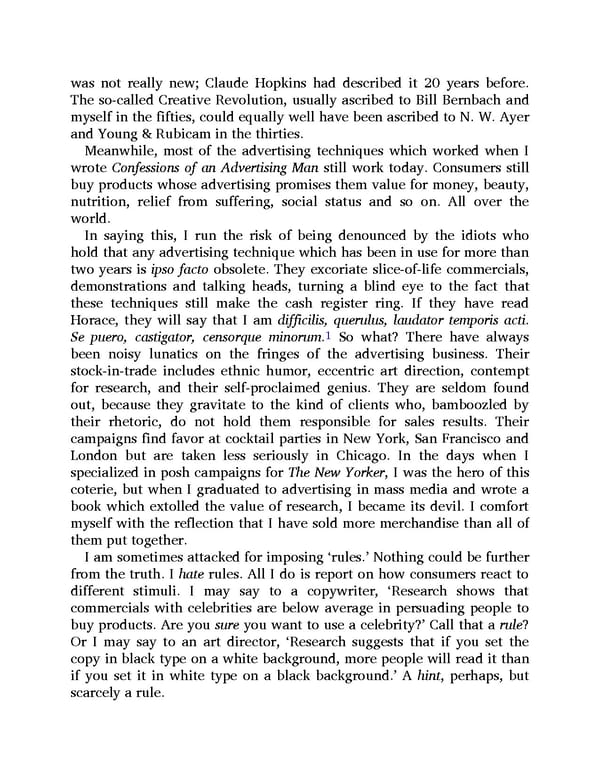was not really new; Claude Hopkins had described it 20 years before. The so-called Creative Revolution, usually ascribed to Bill Bernbach and myself in the fifties, could equally well have been ascribed to N. W. Ayer and Young & Rubicam in the thirties. Meanwhile, most of the advertising techniques which worked when I wrote Confessions of an Advertising Man still work today. Consumers still buy products whose advertising promises them value for money, beauty, nutrition, relief from suffering, social status and so on. All over the world. In saying this, I run the risk of being denounced by the idiots who hold that any advertising technique which has been in use for more than two years is ipso facto obsolete. They excoriate slice-of-life commercials, demonstrations and talking heads, turning a blind eye to the fact that these techniques still make the cash register ring. If they have read Horace, they will say that I am difficilis, querulus, laudator temporis acti. 1 Se puero, castigator, censorque minorum. So what? There have always been noisy lunatics on the fringes of the advertising business. Their stock-in-trade includes ethnic humor, eccentric art direction, contempt for research, and their self-proclaimed genius. They are seldom found out, because they gravitate to the kind of clients who, bamboozled by their rhetoric, do not hold them responsible for sales results. Their campaigns find favor at cocktail parties in New York, San Francisco and London but are taken less seriously in Chicago. In the days when I specialized in posh campaigns for The New Yorker, I was the hero of this coterie, but when I graduated to advertising in mass media and wrote a book which extolled the value of research, I became its devil. I comfort myself with the reflection that I have sold more merchandise than all of them put together. I am sometimes attacked for imposing ‘rules.’ Nothing could be further from the truth. I hate rules. All I do is report on how consumers react to different stimuli. I may say to a copywriter, ‘Research shows that commercials with celebrities are below average in persuading people to buy products. Are you sure you want to use a celebrity?’ Call that a rule? Or I may say to an art director, ‘Research suggests that if you set the copy in black type on a white background, more people will read it than if you set it in white type on a black background.’ A hint, perhaps, but scarcely a rule.
 Ogilvy on Advertising Page 8 Page 10
Ogilvy on Advertising Page 8 Page 10